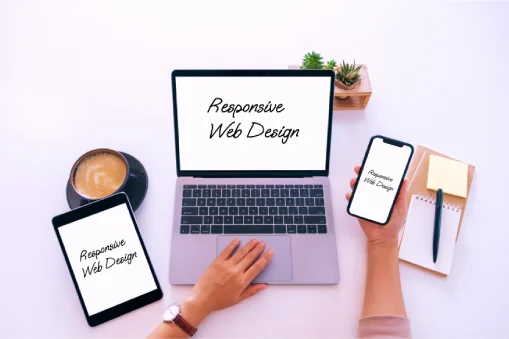In today’s digital landscape, where mobile devices dominate internet usage, having a responsive web design is no longer optional—it’s essential. Responsive web design (RWD) refers to the approach of creating web pages that automatically adjust their layout and content to fit the screen size of the device being used. This design philosophy not only enhances user experience but also plays a critical role in search engine optimization (SEO). In this blog, we’ll explore why responsive web design is crucial for SEO and how it can benefit your website.

Table of Contents
Toggle1. Improved User Experience
The Importance of User Experience
User experience (UX) is a significant factor in how visitors interact with your site. A seamless and engaging UX can reduce bounce rates and increase the time spent on your website.
How Responsive Design Helps
- Consistent Experience Across Devices: Responsive design ensures that users have a consistent and optimized experience whether they are accessing your website from a desktop, tablet, or smartphone. This consistency helps retain visitors and encourages them to explore more of your site.
- Reduced Load Times: Mobile-optimized sites typically load faster, which enhances user experience and satisfaction. A responsive design helps in reducing load times across different devices.
2. Lower Bounce Rates
Understanding Bounce Rates
A bounce occurs when a user leaves your site after viewing only one page. High bounce rates can signal to search engines that your site may not be relevant or engaging.
How Responsive Design Affects Bounce Rates
- Engagement and Retention: With a responsive design, users are less likely to leave your site prematurely, as they can easily navigate and find the information they need.
- Optimized Layouts: Responsive sites eliminate the need for users to zoom in or scroll horizontally, making it easier for them to consume content and explore your site further.
3. Higher Search Engine Rankings
The Connection Between UX and SEO
Search engines prioritize websites that provide a positive user experience. Factors such as bounce rate, time on site, and pages per session can influence your search engine rankings.
How Responsive Design Boosts SEO
- Single URL Structure: Responsive web design uses a single URL for both desktop and mobile versions of a site, making it easier for search engines to crawl and index your content. This eliminates issues related to duplicate content and improves your overall SEO.
- Mobile-First Indexing: Google has transitioned to mobile-first indexing, meaning it predominantly uses the mobile version of the content for indexing and ranking. A responsive design ensures that your site performs well on mobile devices, directly impacting your search visibility.
4. Increased Page Speed
The Role of Page Speed in SEO
Page speed is a crucial ranking factor for search engines. Slow-loading websites can lead to higher bounce rates and lower rankings.
How Responsive Design Affects Speed
- Optimized Performance: Responsive web design can improve load times by ensuring that the appropriate resources are served based on the user’s device. This means that mobile users receive a streamlined version of your website, enhancing speed and performance.
- Image and Asset Management: RWD allows for the optimization of images and other assets for different screen sizes, further improving loading times across devices.
5. Enhanced Local SEO
The Importance of Local SEO
Local searches are increasingly common, especially among mobile users. A responsive design can improve your visibility in local search results.
How Responsive Design Supports Local SEO
- Mobile-Friendly Experience: Many local searches are conducted on mobile devices. A responsive design ensures that users can easily access essential information, such as your address, phone number, and operating hours, improving user engagement and local SEO performance.
- Google My Business Integration: Responsive websites can effectively integrate with Google My Business, making it easier for local customers to find and interact with your business.
6. Cost-Effectiveness
Understanding Cost Implications
Maintaining separate websites for desktop and mobile versions can be costly and time-consuming.
How Responsive Design Saves Costs
- Single Website Management: With a responsive design, businesses only need to maintain one website, reducing development and maintenance costs. This approach also ensures that updates and improvements are applied universally.
- Efficient Marketing Efforts: A responsive site simplifies marketing strategies, allowing businesses to focus their efforts on a single website rather than managing separate campaigns for mobile and desktop users.
7. Better Social Media Integration
The Role of Social Media in SEO
Social media signals can indirectly impact SEO rankings by driving traffic and increasing brand awareness.
How Responsive Design Enhances Social Media Sharing
- Shareable Content: Responsive designs ensure that your content is easily shareable across various social media platforms, increasing visibility and driving traffic back to your site.
- Consistent User Experience: A responsive site provides a consistent experience when users click through from social media, leading to higher engagement and conversion rates.
Conclusion
Responsive web design is not just a design trend; it is a crucial component of effective SEO strategy. By enhancing user experience, lowering bounce rates, improving search engine rankings, and offering cost-effective solutions, responsive design can significantly impact your online visibility and success. As mobile internet usage continues to grow, businesses must prioritize responsive web design to stay competitive and provide the best experience for their users. Investing in a responsive design today will pay dividends in SEO performance and overall business growth tomorrow.


No responses yet